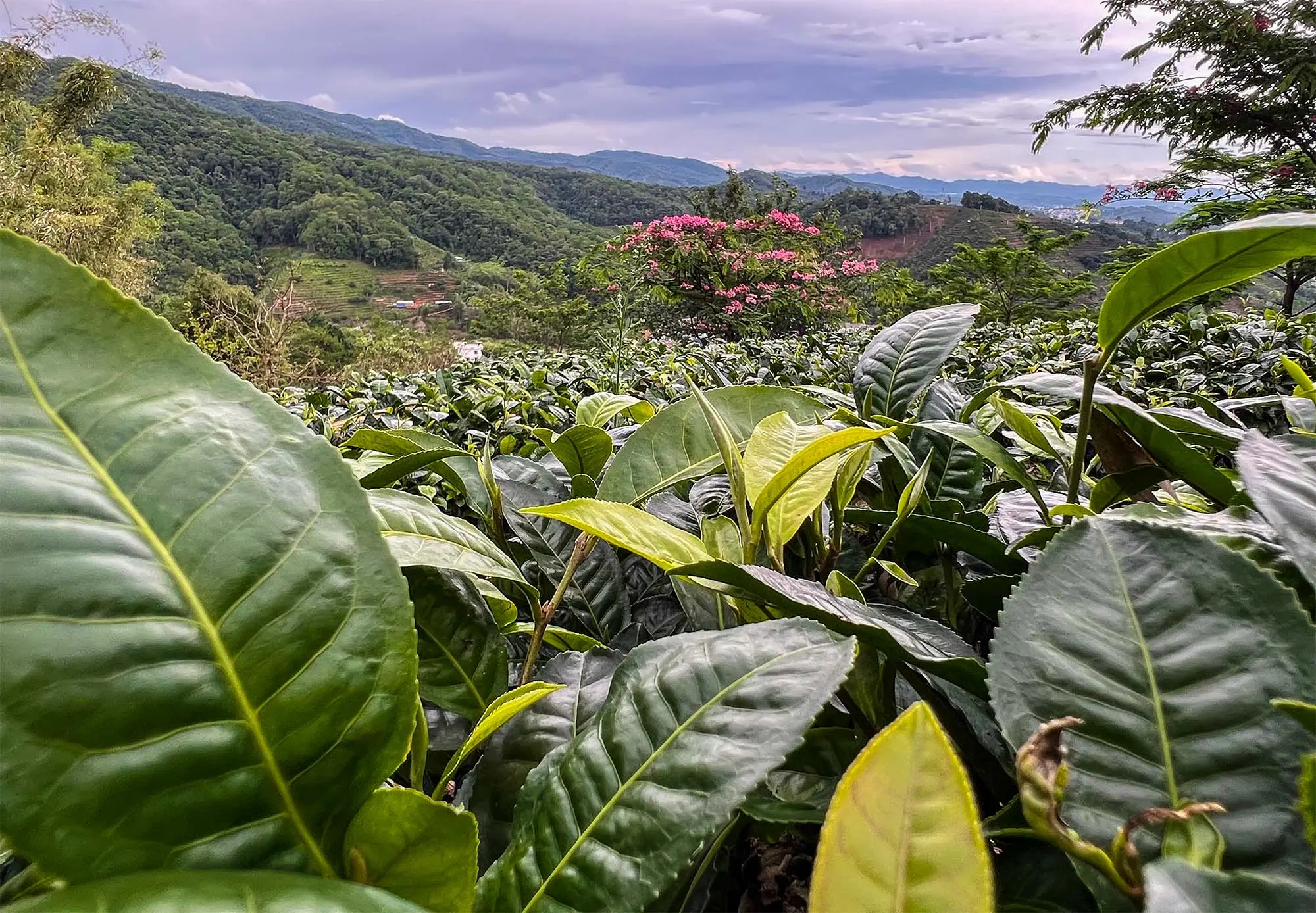Botany of the Tea Plant — The “Foundation” Trilogy, Part I
Before plunging into the depths of Pu’er, it is worth taking a step back to consider the tea plant as such.
The tea plant (Camellia sinensis) has two main forms: the tree (var. assamica) and the bush (var. sinensis). These are entirely different genotypes; one will never turn into the other, though crossbreeding between them is possible.
The distinguishing feature of the tree is not its size, but its single prominent trunk, from which branches emerge at a certain height; the bush, by contrast, grows as a cluster of equivalent stems emerging from a common root. Bushes typically grow no taller than two meters, while trees may reach 15 meters or more. The leaves of the tree are also considerably larger. Trees are long-lived, surviving for centuries or even millennia, whereas bushes live 50 to 100 years.
Historically, the Chinese cultivated bushes from trees specifically for yield: the branching intensity of a bush can reach 12–14 orders of branching, compared with only 5–6 in a tree. The volume of harvestable leaf from bushes is further increased by regular pruning, which stimulates the growth of lateral shoots and branches. The harvesting frequency also differs greatly — while a bush can provide fresh leaf 8–10 times a year, a tree yields no more than three.
Wild trees are never pruned, watered, or fertilized. Leaf from them is always more expensive than plantation material due to the difficulty of harvesting and the small yield. In addition, large factories generally do not work with wild material because of its limited availability — it is processed mainly by small farms.
Trees can be small (xiao shu), large (da shu), straight-trunked (qiao mu, 乔木), old (lao shu), or ancient (gu shu).
Bushes (guan mu, 灌木) can be large or small, but in most cases represent the plantation type, known as tai di cha — “terrace tea.” A plantation consists of bushes planted in rows for the needs of large-scale production — the most basic and commonly encountered source of raw material.
Both bushes and trees have an uncountable number of varieties, many of which are not officially registered. Instead of variety, one sometimes hears the term cultivar, but this word refers to a deliberately bred variety — whereas there are also natural ones (wild-growing types).
The tea plant reproduces both sexually (by seed) and vegetatively (by cuttings). In the first case, each plant has a unique genotype, and consequently unique characteristics. A wild population of natural varieties is essentially a living genetic laboratory, a reservoir of unique genes, where one constantly finds both “weeds” (cai cha, 菜茶) and miracle varieties (qi zhong, 奇种).
However, in large-scale production predictability of results is crucial — which is why on plantations plants are cloned into an army of identical copies through cuttings. But❗️ genetically identical cultivars will nevertheless express themselves very differently depending on their growing environment, or terroir.
The age of the tea plant is an important parameter often used by producers as a quality marker, but it is rather difficult to measure. Commonly, trunk circumference is taken as a reference, but this variable correlates poorly with age, since it depends on soil composition and plant genetics. At times, historical records are cited, from which one can learn the age of entire gardens, though not of specific trees. In the case of tea trees, the method of counting growth rings is not used.
The older the tree, the deeper its roots, and therefore its ability to filter nutrients from the soil increases. However, its metabolic rate slows down, reducing harvest volume. But❗️ even the oldest tree from a second-rate location will be inferior to young trees grown under better conditions — terroir, that is, the sum of climatic and geographic factors such as altitude, soil, and sunlight, has an even greater influence on the taste of tea.
→ Soil. Yunnan is rich in red earth high in iron oxide — the best medium for tea tree growth. If tea grows in sandy rather than clay soils, the plant absorbs fewer nutrients, which affects both its physiology and the taste of the finished product.
Tea trees growing in the wild are surrounded by a wide diversity of other plants and an abundance of fallen leaves, which decompose into humus and enrich the soil with minerals. This contributes to the rich chemical composition of the leaves, and consequently to their health benefits and especially full flavor.
If a producer confirms the organic nature of the terroir with certification, that is of course a strong advantage — but sometimes factories purchase such certificates while still using fertilizers; no one is completely safeguarded against this.
→ Altitude. The elevation at which a tea tree grows affects the temperature fluctuations the plant experiences, allowing it not to expend nutrients during the cold night, effectively “sealing” them in the leaf. Moreover, it has been experimentally proven that with increasing altitude, tea vegetates more slowly — there are fewer leaves, but those that do form contain a greater concentration of beneficial compounds, and therefore become more aromatic. In addition, with altitude the amount of ultraviolet absorbed by the plant increases, to which it responds by producing higher levels of anthocyanins, pigments that give the leaf a purple color. (I wrote about purple tea here.)
